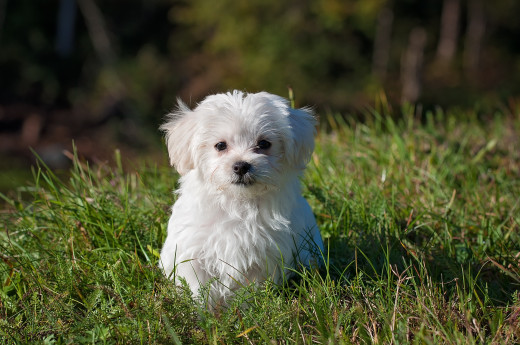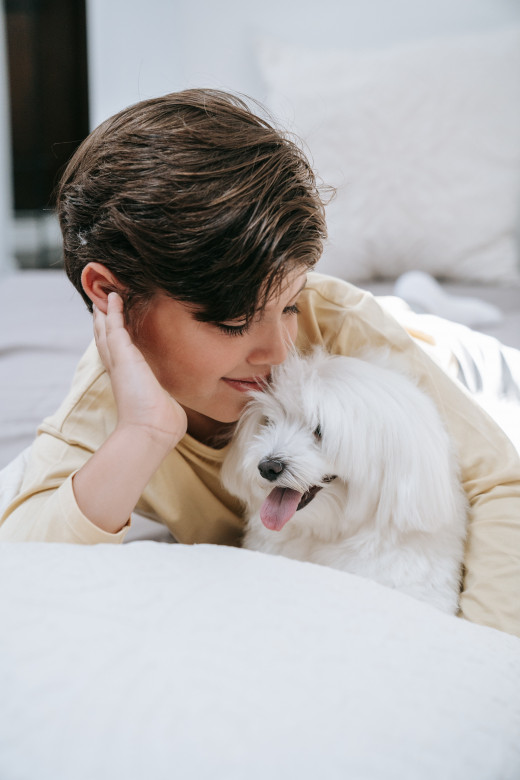
Maltese Stats!Classification: Standard or Toy GroupWeight: 5-12lbs. (2.3 -5.4Kg)Height: 7.5-10 inches (19-25.5 Cm)Life Span: 12-14 years
Maltese make good family dogs, they are recommended for families with older children. However, if can show your toddler how to be gentle with the dog, and monitor child-dog interactions, these dogs can do well with children of all ages. This dog makes a tiny, cuddly companion and loves attention. They are known to have plenty of energy and be very playful. The Maltese prefer enclosed spaces and does well in small yards and even in apartments or townhouses.
Due to their small size, the Maltese is physically very fragile. This is why the breed is not recommended for young children. Accidently stepping on the dog, or sitting on your Maltese can cause the dog broken bones and other serious injuries.
A Maltese requires plenty of socialization as a puppy to feel comfortable in a variety of social situations. This breed may bark and snap at young children, because the dog does not understand children’s quick movements, noises, or indirect rough play (like pulling ears and tails). Again, dog and child interaction needs to be monitored. It is important to have a dog that is well socialized prior to introducing children to the dog, and it is equally important that a child understand how to greet and play respectfully with the dog.
Maltese Have Great Character and Temperament
Maltese have great character and temperament. When inadequately socialized to the family’s daily routine, this little dog does very well.
However, the Maltese may become anxious when left alone. Separation anxiety causes the dog to manifest many destructive behaviors when the family is out of the house.
This breed is often brought to shelters or abandon by owners who can not tolerate their barking, their snappiness with young children or their separation anxiety issues.
Before getting your family a Maltese, make sure your family can tolerate the Maltese’s behavior for both the good and the bad personality quirks. It is unfair to the dog and children to break hearts when the dog is not the right fit for your family.
These dogs are known to be hypoallergenic and can be more pleasant for people who are normally allergic to animals. This breed requires daily grooming of their fur and coat.
It is a great opportunity for children to take on age-appropriate tasks of responsibility. These dogs also get tear-stained fur around their eyes on a daily basis and need daily eye cleaning. Caring and grooming your Maltese helps promote bonding between your family and your dog. Maltese have a great character and temperament overall, and they are easy to love.

Family Life with a Maltese
Maltese make good family dogs for families with older children. This dog makes a tiny, cuddly companion and loves attention. They are known to have plenty of energy and be very playful. The Maltese prefer enclosed spaces and does well in small yards and even in apartments or townhouses.
Due to their small size, the Maltese is physically very fragile. This is why the breed is not recommended for young children. Accidently stepping on the dog, or sitting on your Maltese can cause the dog broken bones and other serious injuries.
A Maltese requires plenty of socialization as a puppy to feel comfortable in a variety of social situations. This breed may bark and snap at young children, because the dog does not understand children’s quick movements, noises, or indirect rough play (like pulling ears and tails).
Maltese Breed History
The Maltese dog is believed to have originated from the Central Mediterranean Area, from the island – Malta, where the dog was a companion to noble women.
The Maltese was specially bred to achieve its tiny size. In the 17th and 18th century the breed was made even smaller so that the dogs were about the size of a squirrel. The breed traveled with the nomadic tribes through Europe and the Middle East where the dog protected the people from rodents.
In 1888, the purebred Maltese was recognized by the American Kennel Club. This little dog has a classic “halo” effect around the eyes, meaning the dark eyes are surrounded by darker skin pigmentation. The Maltese’s nose can become pink or brown in winter, “winter nose” and darken in the summer as a result of sun exposure.
In recent years, the Maltese has been bred with Poodles, Pugs and Shih Tzus to accomplish more desirable and social traits such as being smaller, more friendly, and shed as little as possible.
Maltese Health
Although most Maltese are healthy, the breed is susceptible to some specific dog health issues. Some health issues that can affect the Maltese breed are:
Luxating Patella – Or sliding knee cap, causes pain when walking. Treated with surgery.
Liver Shunt- When the blood circulates abnormally and bypasses the liver which is important for detoxifying and cleaning the blood. Treatable through diet, medication and surgery. This condition can also cause the dog to become anemic, if treatment and diagnosis are delayed.
Eyes infections from inadequate cleaning, or infrequent cleaning.
Developing a strong relationship with a trusted veterinarian is important to maximize the health of your Maltese.

